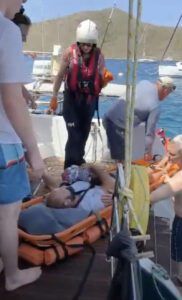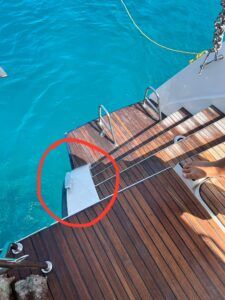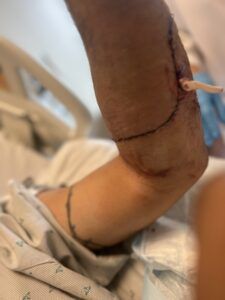Just another beautiful BVI day. The forecast was for 87 degrees and sunny and the weather Gods were in fine form, with a predictable breeze out of the east that made us forget the advent of hurricane season.
It was June 21st, 2023— day three of a seven-day charter on board Ventana, a 52-foot Lagoon catamaran. The guests—two nuclear families with two parents and two children each, both from California—had enjoyed some diving the day before followed by a raucous nightcap at the Willy T, Norman Island’s famous, or maybe infamous, floating pirate ship bar and restaurant.
This morning was marked by a slower start, a slightly later breakfast, and the ordinary in-water exploration of the mooring field’s recovering reefs. After their morning swim, the ladies opted for a quick hair wash on the transom to get the salt out before departing for Virgin Gorda. It was the wash that started it all.

SITUATION CRITICAL
I’m a seasoned charter captain and sailor with thousands of miles under my keel. I was about to have a very bad day. I was going about the business of tying the tender off on the stern lift in preparation for the next short hop. The task half complete, I walked to the port side of the Lagoon to tie the dinghy’s bow line off, and as I came to the wet aft deck, I slipped on some unrinsed shampoo and went airborne. I put my arm down to brace my fall. I barely saw the stern cleat when my forearm hit it—hard. I felt my fall slowing and saw my feet slide off the side of the sugar scoop. My attention was immediately drawn back to my left forearm as it was now radiating with pain. In the seconds I was falling it looked like the bones in my arm had snapped in two. In hindsight, that would have been a far better outcome.
In reality, the cleat had pierced my arm, and now I was hanging from it off the transom of the boat. I could see clearly where the cleat had entered my forearm about two inches from my elbow, the top of it reappearing near my wrist. My hips were just out of the water, buoyancy offering me almost no assistance, and I was more than a little jarred from what just happened. My first thought was to reach up to the transom with my right arm and lift myself off the cleat. This was a unique situation. I was unsure if adrenaline would insulate me from the shock of dropping back onto my injured arm after an unsuccessful attempt to free myself. I had to remain conscious and get myself off that cleat.
Somehow I managed to pull my arm free, and I swam to the sugar scoop while calling to the crew and guests. I would need a doctor immediately. During the brief swim I kept my arm out of the water and gave myself a quick self exam.

I was able to see that a very large portion of the skin of my forearm had been peeled away, as well as the forearm muscle itself, exposing the bone. Also obvious was the arterial bleeding that ran the risk of ending my life if I didn’t get it stopped. The adrenaline was flowing. Help was many miles away on Tortola.
ONBOARD ASSETS
Two of the gentlemen guests from the charter were waiting for me at the transom. One of them happened to be a gastroenterologist. With very little help from me, they were able to get me back aboard. Various guests were dispatched to grab towels and anything else that could absorb blood. Realizing that something had happened but not fully grasping the severity, the chef emerged from his cabin. By this time I was seated at the aft cockpit table and had resumed my role as captain. As much as I tried to leave my role as victim, my badly injured arm wouldn’t let me. I did my best to assure the guests that while this wasn’t normal it was under control, even though it wasn’t….. yet.
I asked the Chef, Jeremiah, to get me the handheld VHF. His response left me aghast, “What’s a VHF?”
Trying to measure my response, I explained to him that, “It’s the hand held radio at the helm”. Again I was shocked by his reply, “What’s a helm”
My response no longer mattered, and perhaps sounding more harsh than necessary, I explained it was “the big round thing I steer the f&%#$g boat with.” Hastily he dashed away to get the requested item.
Now holding the radio in my shaking hand I double checked that I was on channel 16. I looked at the guest, who was holding pressure on my nearly severed arm and noted that I had never had to call in a Mayday. I started to cry as I held my head in my hand, keyed the mic, collected myself, and said calmly.
“Pan Pan Pan, this is the sailing vessel Ventana, Break, we are at Norman Island with zero one persons critically injured with a major laceration to the left forearm. Break. We need immediate medical evacuation. Any vessels in the area able to give assistance are requested to do so. Ventana standing by on one six”
The Pirate’s Bite, a beachfront restaurant serving the mooring field as well as day-charter guests, responded, saying that they would call VISAR (Virgin Islands Search and Rescue, the BVI’s answer to the US Coast Guard.)
The next call was the one for which I will be forever thankful,
“Ventana, This is Southern Charm, Over”
“Southern Charm, Ventana. Send your traffic.”
“Rob, are you still on the same ball you were on earlier?”
“Affirmative.
“Good Copy, were close by. We will turn around right now.”
“Copy Southern Charm, Thanks. Ventana standing by on one six.”
Kevin and Elizabeth, owners and operators of Southern Charm, a Leopard 50 doing term charters in the BVI, had been friends of mine for a couple of years. I knew they were on charter. It felt like an hour before they got to Ventana, but in reality they took only a few minutes. They both boarded our vessel with their trauma kit and immediately replaced the field-expedient tourniquet with their personal one. The doctor on board asked one of the other guests to set a timer for eight minutes, after which we would loosen the tourniquet briefly to allow blood to flow back to the hand in hope of saving it. We did this cycle a couple of times while Kevin relieved me as the radio operator. I was fading fast.
Supplement your boat’s first-aid kit with any items that will help stop bleeding. Stopping bleeding is rule one. In my case, it would have been helpful to have a roll of Saran Wrap or Cling Wrap ready to go. The tourniquet helped, but I was glad my guest the gastroenterologist knew to loosen that every eight minutes to restore blood. He probably saved my hand. Brief your guests on the action plan if someone gets badly hurt on board. Stopping blood. Restoring respiration. Stopping shock. All these things are critical. If you’re the client, ask your charter company if the crew of your boat has had first-aid or CPR training. The answer will be an emphatic yes if your captain is licensed. If you’re sailing with older people —your parents for example—you’ll want to know if there is an automatic external defribrilator (AED) on board. And maybe oxygen. Your pre-departure checklist should include the basics on where PFDs, signal devices, and fire extinguishers are located. Always, always… adults need to pay attention to keeping kids safe, not reaching for another Pussers. (Are they wearing their PFDs?) But brief your passengers on how to use the radio, or a cell/sat phone. Assess the capabilities of passengers. Can they start the engine, get the anchor up, and start motoring for help if the captain is not availble? Captains and crew in various charter operations need to communicate regularly about the local action plan if a person needs to be rescued and transported. Lending a helping hand to a fellow mariner is an inviolate part of our culture. Where would I have been without Kevin and Elizabeth? Their, timing, skill, and reassurance changed everything and probably saved my arm, my sailing career, perhaps my life. Talk to each other, and have each others’ back. Leave your ideas…or tell us your story… in the comments.
VISAR arrived on scene only a few minutes later, took a very cursory glance at my injury and slid me onto a backboard. With Kevin’s help, VISAR personnel slid me onto the fast, yet highly uncomfortable boat they’d use to take me to a waiting ambulance. I was unconscious for the first part of the ride, jarred awake occasionally by pain. My Arm was wedged between me and the boat’s hull. As we bashed our way to Tortola’s capital of Road Town, my arm alerted me to every wave we crashed into. Elizabeth, despite her responsibilities to her charter guests, volunteered to accompany me to the hospital. The captain’s comment still sticks with me.
“He can die in the ambulance, he’s not dying on my boat.”
WHO ARE YOU GOING TO CALL?

I was again jarred awake at the dock as I was shuffled off the rescue boat onto the ground outside the waiting ambulance. I must have overheard the discussion going on in my cerebral absence about how to best move me to the ambulance. I awoke with a start, and exclaimed that I could walk. I stood up, and under my own power shuffled myself to the ambulance with only a little assistance. A very slow and very bumpy ambulance ride later, I was at Peebles Hospital in Tortola.
In a bit of a haze, and with adrenaline now wearing off, I answered questions already answered about next of kin, emergency contacts and whom they should call to get my blood type. As a US Marine (you’re never a “former” Marine), I should have had this Information at my disposal but at that moment I could neither recall my blood type nor a single phone number other than that of my ex wife. They called her in search of my blood type for the transfusion that I would certainly need. She answered their call but not their question, replying “Call someone who cares.”
After some sleuthing on Elizabeth’s part they were able to reach my sister, who told them I was O-positive, making it possible for me to receive the lifesaving blood to replace some of what I’d lost. For the first time since the accident, now just an hour ago, I thought there was a chance I’d live.
Steadfast and always encouraging, Elizabeth stayed at my side until they took me back to surgery. Riding in the elevator to the operating theater—under the influence of pain meds—I was relieved to learn that the worst case scenario only involved the loss of my hand. I asked Elizabeth, “If they take my hand, Will you please tell them to give me a hook as a prosthetic?”
Elizabeth, always sharp, told me, “Better yet, I’ll have them install a winch handle.”
Waking from surgery in the BVI’s finest recovery room, I was pleased to see Elizabeth had not given up her post at my side. I was groggy but she made clear to me that the prosthetic winch handle was not in the cards. I still had ten fingers and would potentially regain the use of most of them.
Five days later I was released from the hospital and hitched a ride back to the US Virgin Islands where my commissioned boat was. A few days later, I was back on charter and back in the water shortly thereafter. My recovery process may have suffered from these post-op decisions but everyone likes a gnarly scar right?







































A frightening story. We quickly forget that this water borne adventure we take can be/is dangerous. Although our advanced age means that our only sea time is traveling from San Diego to Avalon, Catalina, some 75 miles.
I am going to review our med kits and make sure my wife and I are ready to handle a medical emergency.
Thank You for posting.
Glad your back on your boat, good point about blood type, I have no idea what mine is. Stay well Rob!
Captain Hyson, you sir, are someone I would willingly follow into battle. Glad you’re doing well.
I just did a quick Google search and loosening the tourniquet is an outdated practice that is no longer practiced. Am I wrong?
I’m surprised PS editors let that one slip by.
I was surprised to read that as well. I will only say that whatever first aid response or medical treatment you initiate, it has to reflect your training – never go beyond it unless someone over the SAT Phone/Starlink/SSB/cellphone is directing you. My training is inline with your comment – apply the tourniquet to stop the blood flow if direct compression or stop-the-bleed kits are ineffective; or the damage is so severe that using a tourniquet has to be used immediately to give the patient the best chance to survive and – here is what you’re talking about – leave it tight, don’t mess with it. If that one is not successful, apply a second one above (proximal to) the first one that is left in place. While time is not your friend in this case, additional interventions also has to be considered; maintaining an airway after getting the bleeding under control and treating for shock. From the time of injury, you have about 2hrs to get to a medical team that can address this type of injury with a small chance of losing the extremity (of course it depends upon the extent of damage, no infection, etc….). Beyond that, no one can really say. Bear in mind if the injury was due to a shark bite or cut from using or coming into contact with machinery, the tourniquet(s) again are used to try to stabilize that person and get them to medical team in less than an hour to give them the best chance possible.